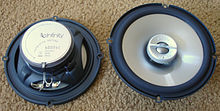Infinity story
The Infinity brand was founded in 1968 in a garage by Arnold “Arnie” Nudell, a nuclear physicist and musician, and by Cary Christie and John Ulrich. The trio knew each other from their time working together at Hughes Aircraft. The company has been part of the Harman International Group since 1982.

Speakers from Infinity
Infinity was regarded as innovative for new developments. The first loudspeaker developed in-house, Servo Static 1, left the familiar loudspeaker designs of the time back in 1968. It had an external crossover and a bass speaker separate from the main speakers with a motion detector. The breakthrough in the hi-fi and high-end sector came in 1978 with the successful “Reference Standard” series, which reached its peak in the years from 1981 to 1986. In 1987, the “Reference Standard” series was replaced by the no less successful “Kappa” series.
The brand’s flagship, the Infinity “Reference Standard Mk5” (also known as the IRS MkV), was of particular importance. This system was at times considered the most expensive and, for many, still the best loudspeaker in the world. There were five model generations under the brand name Infinity in the years 1980-1988; after the new brand “Genesis” was founded, Nudell built the successor to the “Reference Standard” there and continued it under the name “Genesis 1.1”.
The two models “Renaissance 80” and “Renaissance 90” were the first models developed solely by Cary Christie. The “Beta” and “Gamma” became classics in 1987-1993, the models “Renaissance 90” and “Renaissance 80”, “Epsilon”, “Sigma” and “Omega” were the last representatives of the classic design philosophy. The “x.1” and “x.2” models built from 1994 to 1998 follow modified construction principles. However, with filled polypropylene cones for the bass and bass-midrange drivers and large polypropylene domes for the midrange drivers, they have the classic features of the “Kappa” series. In contrast to the older “Kappa” and “Reference Standard” models, a magnetostat with a straight foil cone (EMIT) is used as the tweeter; instead, a version with a round cone (EMIT-R) is used. Arnold Nudell also uses magnetostat tweeters with a round cone in the loudspeakers of his current “Genesis” brand.
For fans of the brand, the company history of Infinity ended with the departure of Arnie Nudell. The two models Renaissance 80 and Renaissance 90 were the first models developed solely by Cary Christie. The “Beta” and “Gamma” became classics in 1987-1993, the Renaissance 90 and 80 models, Epsilon, Sigma and Omega were the last classic Infinities. Some fans of the Infinity Classics only accept the 1994-1998 x.1 and x.2 models as classic Infinity to a limited extent. However, they have classic Infinity Kappa features with filled polypropylene cones for the bass and bass-midrange drivers and large polypropylene domes for the midrange drivers. The tweeter is no longer a magnetostat with a straight foil diaphragm (EMIT) as in the older Kappa and Infinity Reference standard models, but one with a round diaphragm (EMIT-R). Arnie Nudell also uses magnetostat tweeters with a round cone in the loudspeakers of his current Genesis brand.
The company’s current product range includes loudspeaker systems and amplifier power amplifiers for the car hi-fi sector.
http://www.infinitysystems.com/
